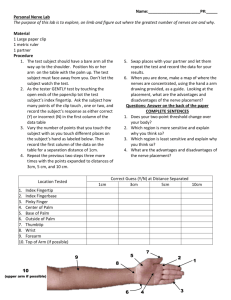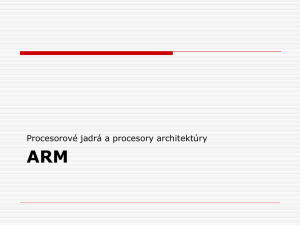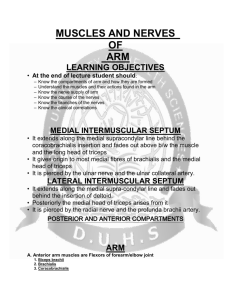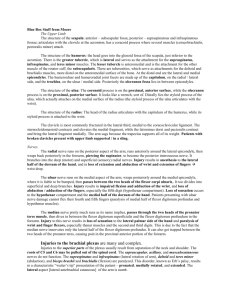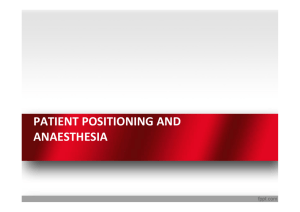Patient Positioning - Conemaugh Health System
advertisement
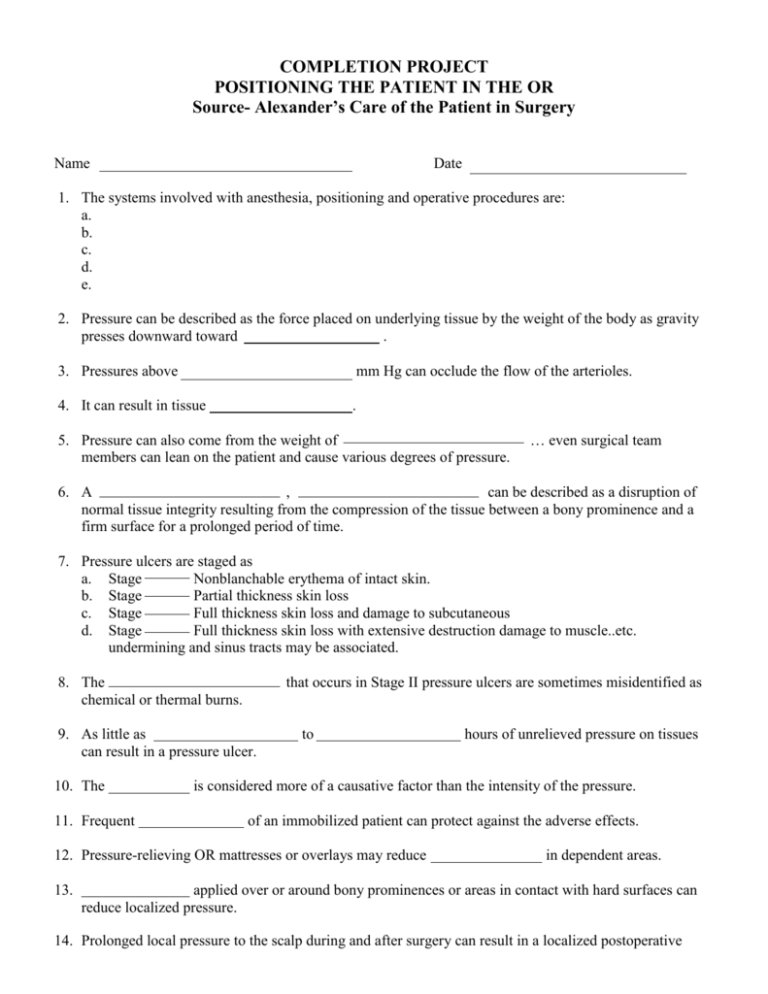
COMPLETION PROJECT POSITIONING THE PATIENT IN THE OR Source- Alexander’s Care of the Patient in Surgery Name Date 1. The systems involved with anesthesia, positioning and operative procedures are: a. b. c. d. e. 2. Pressure can be described as the force placed on underlying tissue by the weight of the body as gravity presses downward toward . 3. Pressures above mm Hg can occlude the flow of the arterioles. 4. It can result in tissue . 5. Pressure can also come from the weight of members can lean on the patient and cause various degrees of pressure. … even surgical team 6. A , can be described as a disruption of normal tissue integrity resulting from the compression of the tissue between a bony prominence and a firm surface for a prolonged period of time. 7. Pressure ulcers are staged as a. Stage Nonblanchable erythema of intact skin. b. Stage Partial thickness skin loss c. Stage Full thickness skin loss and damage to subcutaneous d. Stage Full thickness skin loss with extensive destruction damage to muscle..etc. undermining and sinus tracts may be associated. 8. The chemical or thermal burns. that occurs in Stage II pressure ulcers are sometimes misidentified as 9. As little as can result in a pressure ulcer. 10. The 11. Frequent to is considered more of a causative factor than the intensity of the pressure. of an immobilized patient can protect against the adverse effects. 12. Pressure-relieving OR mattresses or overlays may reduce 13. hours of unrelieved pressure on tissues in dependent areas. applied over or around bony prominences or areas in contact with hard surfaces can reduce localized pressure. 14. Prolonged local pressure to the scalp during and after surgery can result in a localized postoperative . Completion Project, Positioning the Patient in the OR– Page 2 15. Recommendations are to reposition the patient’s head every 16. Ring cushions…have been known to cause . minute (to reduce alopecia). . , and 17. The weight of the head is more evenly distributed on a , , with an induction rather than a hole in the center. 18. Patients on also have diminished tissue tolerance and delayed wound healing. 19. Pre-existing chronic diseases such as pressure sores. 20. , also increase the risk of forces also cause damage to tissue integrity. This can happen when the head of the bed is raised or lowered and when the patient is placed in Trendelenburg’s or reversed Trendelenburg’s position. Shear is created by a force. Pressure is created by a perpendicular force. 21. of being 22. , or a on the patient’s skin can occur when the body is dragged across the bed linen instead . This can denude the epidermis to make the skin prone to infection. can exacerbate the effects of pressure, shear and friction. This occurs when prolonged moisture on the skin saturates the epidermis…This can occur in surgery if the patient perspires or lies in a poll of prep solution. (This can also lead to chemically induced contact dermatitis.) 23. Anesthetics and muscle relaxants prevent the patients defense mechanisms from guarding against joint damage, muscle stretch and . 24. When nervous system depression occurs, the body’s communication and command system become totally or partially . 25. Pressure on superficial nerves can cause temporary or permanent damage. 26. The most commonly reported nerve injuries involve the nerve, the plexus, the nerve roots and the lower extremity nerves. 27. The nerve is a peripheral nerve that passes from the upper arm through the groove of the medial epicondyle of the to the lower arm. 28. Ulnar nerve compression close to the elbow results in of the ring and distal fingers. 29. The brachial plexus is a network of nerves that run beneath the clavicle and down the upper arm. The nerve branches include the , , , musculo-cutaneous and axially nerves. 30. When the arm is extended on an arm-board in excess of a 90o angle from the body, the brachial plexus may be stretched and compressed between the and first rib. 31. If the head and neck are turned in an opposite direction from the extended arm, even more is exerted so that compression may occur at less than 90%. Completion Project, Positioning the Patient in the OR– Page 3 32. Distal branches of the nerves can be compressed by tight arm or wrist straps or resting against the mattress edge or metal frame of the OR bed. can affect the entire arm, wrists and hand. 33. General anesthesia causes peripheral vessels to … Blood pressure drops… In general anesthesia, these effects are . With spinals and epidurals, these effects are limited to the areas anesthetized. 34. Position changes affect where the pooling of blood occurs. Blood pooling will shift to whatever part of the body is . 35. Position changes may need to be delayed until the blood pressure is . 36. Compression to peripheral vessels can occur from the safety strap or wrist restraints… Such compression can predispose the patient to venous . 37. is also a risk of hyperabduction of the arm beyond 90 degrees. 38. Obese patients, pregnant patients and patients with respiratory insufficiency may have difficulty . 39. A safety strap should be placed inches above the knees. 40. Sequential comparison stockings are applied as prophylaxis against? (page 165). , , . MATCHING PART I 41. Supine (dorsal recumbent) a. Extension of these should be less than 90O angle 42. Armboards b. Head up feet down 43. Arms c. Most common position permits access to major body cavities d. Lying with the abdomen on the surface of the OR mattress, patient is induced supine and four people are needed to log roll e. Should be tucked with a drawsheet, around the arm and under the body, not under the mattress f. Often used for hemorrhoid and pilonidal sinus surgery g. Upper torso is lowered and the feet are raised. Knees should be over the break. 44. Trendelenburg’s position 45. Reverse Trendelenburg’s position 46. Lithotomy 47. Semi-Fowler’s (lawn chair) 48. Fowler’s 49. Prone 50. Jackknife position (Kraske’s) Completion Project, Positioning the Patient in the OR - – Page 4 Matching Part I (Continued) h. Upper body section is raised 90O while knees are slightly flexed and legs are lowered. Use a foot rest. i. Upper body is flexed 45 O , leg section is lowered flexing the knees. j. Patient is supine, legs are raised and abducted to expose the perennial region. Legs should be raised simultaneously to prevent strain on the patient’s lower back. Lower simultaneously and slowly to allow blood to shift. MATCHING PART II 51. Prone and Jackknife a. Patient is lying on the non-operative side, providing access to the upper chest . Right lateral indicates the patient is lying on the right side. b. A further exaggeration of jackknife. c. The lower arm is flexed to rest on the armboard lower, shoulder brought slightly forward. 56. Lateral kidney position d. Safety strap placed on the dorsal aspects of thighs. 57. Kidney braces e. Small shorter one placed against patients back. Longer larger one placed anteriorly near iliac crest. 58. An important nursing intervention when positioning patients. f. Ensure that legs are not crossed to prevent pressure on nerves and blood vessels. g. Upper arm flexed and raised above the head. Lower leg position varies. h. The patient is positioned so that the lower iliac crest is just below the lumbar break. The kidney bridge is raised and the bed is flexed. 52. Knee – chest position 53. Lateral 54. Lower arm in lateral position 55. Lateral chest position. F:\SNSHARE\SURGTECH\WRKSHTS\POSITPT.DOC PP:ldh ALEXANDER COMPLETION PROJECT POSITIONING THE PATIENT IN THE OR Answer Sheet 1. 2. 3. 4. 5. 6. 7. 8. 9. 10. 11. 12. 13. 14. 15. 16. 17. 18. 19. 20. 21. 22. 23. 24. 25. 26. 27. a. Integumentary b. Musculoskeletal c. Nervous d. Cardiovascular d. Respiratory The surface of the bed - lumbosacral 32 mm Hg Ischemia Equipment Pressure ulcer I, II, III, IV Blistering 2 to 3 Duration Repositioning Pressure Padding Alopecia 30 Venous congestion and edema Soft pillow, contoured headrest Steroids Diabetes mellitus Shear – parallel Friction lifted Maceration Strain Ineffective Nerve Ulnar, brachial, lumbosacral Ulnar, humerus 28. 29. 30. 31. 32. 33. 34. 35. 36. 37. 38. 39. 40. 41. 42. 43. 44. 45. 46. 47. 48. 49. 50. 51. 52. 53. 54. 55. 56. 57. 58. Clawing Ulnar, median, radial Clavicle Pressure Numbness Dilate, systemic Lowest Stabilized Thrombosis Thrombosis Breathing 2 Deep vein thromboses C A E G B J I H D F D B A C G H E F


